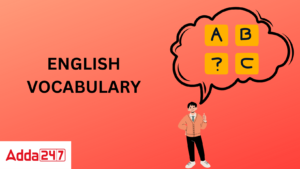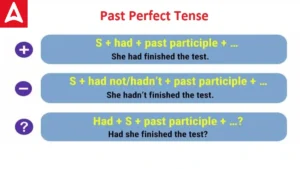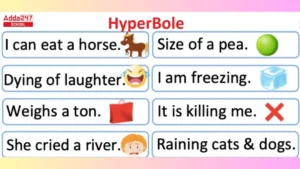The tenses used in the English language are fascinatingly woven together to convey various characteristics of time. The present perfect tense is among this tapestry’s most fascinating and adaptable motifs. With the help of this lovely verb tense, which connects the past and present, we may describe actions that take place in both periods. We will examine the construction, application, and grammatical significance of the present perfect as we delve into its complexities in this article.
Present Perfect Tense
The present perfect tense is a tense used to describe an action that has already happened at a given time. It employs verb + ed as the primary verb and an auxiliary verb and past participle. I’ve watched this movie before, and He finished his homework are two instances of this tense.
To show a connection between the present and the past, we utilize the present perfect. In other words, the action took place in the past but at an unspecified time. In reality, we are generally more interested in the results than the activity itself. The past participle and have/has combine to generate this tense.
Present Perfect Tense Definition
In English, the present perfect tense is “the form of a verb that describes an action done in a time period up to the present, constructed with the present tense of “have” and the “past participle” of the verb, as in I have eaten,” according to the Oxford Learner’s Dictionary. The present perfect is described as “the form of the verb used for actions or occurrences that have been accomplished or have happened in a span of time up to now” by the Cambridge Dictionary.
The Collins Dictionary provides a much more detailed explanation, stating that “the present perfect of a verb are used to talk about things that happened before the time you are speaking or writing but are relevant to the present situation, or things that started in the past and are still happening.” The present perfect is described as a verb tense that “expresses an action or state begun in the past and completed at the time of speaking (as in “I have finished”) or continuing in the present (as in “We have lived here for several years”). This definition is taken from the Merriam-Webster Dictionary.
Present Perfect Tense Formula
The general formula of the Present Perfect is given below
Subject + have/has + past participle (third form of the verb) + rest of the sentence.
The formation of this tense can be analyzed with reference to positive, negative, interrogative, and negative interrogative types of sentences. Have a look at the table given below for a better understanding.
Present Perfect Tense Formula-Based Sentences Formation Structure |
|||
| Positive | Negative | Interrogative | Negative Interrogative |
| Subject + have/has + past participle + the rest of the sentence | Subject + have/has + not + past participle + the rest of the sentence | Have/has + subject + past participle + the rest of the sentence? | Have/has + subject + not + past participle + the rest of the sentence?
(or) Haven’t / hasn’t + subject + past participle + the rest of the sentence? |
| Examples
· We have played cricket on the ground. · He has written a story. · They have worked on this project. · She has recited a poem in the classroom. · I have watered the plants.
|
Examples
· We have not played cricket on the ground. · He has not written a story. · They have not worked on this project. · She has not recited a poem in the classroom. · I have not watered the plants.
|
Examples
· Have we played cricket on the ground? · Has he written a story? · Have they worked on this project? · Has she recited a poem in the classroom? · Have I watered the plants?
|
Examples
· Have we not played cricket on the ground? · Haven’t we played cricket on the ground? · Has he not written a story? · Hasn’t he written the story? · Have they not worked on this project? · Haven’t they worked on the project? · Has not she recited a poem in the classroom? · Hasn’t she recited the poem?
· Have I watered the plants?
|
Present Perfect Tense Rules
Rules to be followed while using Present Perfect Tense
Before using the present perfect, the first thing you must understand is how past participles are created. In most circumstances, adding an “ed” to the basic form of the verb in English creates a past participle. Many irregular verbs, on the other hand, have unusual spellings and do not follow the regular verbs’ pattern of adding “ed” to the base form. To examine how these verbs are in their past participle forms, you might look at the list of irregular verbs.
The very next thing to remember is that a sentence with the past perfect form of the verb employs two verbs: a helping verb and the main verb. The two helping verbs used are ‘have’ and ‘has’. When the pronouns ‘I,’ ‘you,’ ‘they,’ or plural nouns act as the subject in a sentence, ‘have’ is used. When the pronouns ‘he’, ‘she,’ ‘it,’ or singular nouns act as the subject, ‘has’ is used.
Why do we use the Present Perfect Tense?
- An action or situation that began in the past and is still ongoing.
- A recurring action in an unspecified time between the past and the present.
- To connect the events of the present with the events of the past.
- An action that was completed recently. The word ‘just’ is used to express it.
Difference between Simple Past and Present Perfect Tense
The distinction between the present perfect and the simple past tenses could be confusing to you as a language learner.
They both, after all, refer to previous events that have already happened.
I’m hoping that after reading this post, you will be able to distinguish between the two without ever being in doubt again.
- When discussing events that have already ended, the simple past is used. The event will take place at a specific time, and its details are known.
- Generally speaking, the present perfect denotes an action that began in the past and continues up until the present or has some effects in the present.
Present Perfect Tense Examples
|
Examples of Present Perfect Tense |
|
| Pronouns / Nouns |
Examples |
| I | I have worked as an educator for two years. |
| You | You have worked as an educator for two years. |
| We | We have worked as educators for two years. |
| He | He has worked as an educator for two years. |
| She | She has worked as an educator for two years. |
| They | They have worked as educators for two years. |
| It | It has been here the whole time. |
| Singular noun | Joy has worked as an educator for two years. |
| Plural noun | Vedika and Rachna have worked as educators for two years. |
Important Past Perfect Tense Examples
The present perfect tense is used to describe actions or events that began in the past and continue to the present. It is formed with the present tense of the verb “have” plus the past participle of the main verb. For example:
- “I have been to France three times.” (The action of going to France started in the past and continues up to the present.)
- “She has been working at the company for five years.” (The action of working at the company started in the past and continues up to the present.)
- “They have had a great time at the party.” (The action of having a great time at the party started in the past and continues up to the present.)
- “He has just arrived home.” (The action of arriving home started in the past and continues up to the present.)
- “We have already finished the project.” (The action of finishing the project started in the past and continues up to the present.)
Present Perfect Tense Worksheet
To make a statement in the present perfect tense, write the correct form of the verb that is indicated in the brackets.
- John _________ his friend in the 150 m race. (beat)
- The snake ___________ on his leg in the jungle. (bite)
- _____ you ______ all the documents carefully? (keep)
- The dust __________ everywhere in the kitchen. (blow)
- She ___________ anything yet for the party wearing. (not/ choose)
- _____ she ______ this task completely? (do)
- He _______ most of the time playing video games. (spend)
- She _________ a single word yet. (speak)
- Where _____ you _______ yesterday? (sit)
- I __________ this novel many times. (read)
Present Perfect Tense Exercise
Check your answers of the the previous Present Perfect Tense exercise questions.
- John has beaten his friend in the 150 m race. (beat)
- The snake has bitten on his leg in the jungle. (bite)
- Have you kept all the documents carefully? (keep)
- The dust has blown everywhere in the kitchen. (blow)
- She has not chosen anything yet for the party wearing. (not/ choose)
- Has she done this task completely? (do)
- He has not spent most of the time playing video games. (spend)
- She has not spoken a single word yet. (speak)
- Where have you sat yesterday? (sit)
- I have read this novel many times. (read)
Present Perfect Tense Examples in Hindi
- मैं मैंने एक शिक्षक के रूप में दो साल तक काम किया है।
- आप आपने दो साल तक एक शिक्षक के रूप में काम किया है।
- हम हमने दो साल तक शिक्षकों के रूप में काम किया है।
- उन्होंने दो साल तक एक शिक्षक के रूप में काम किया है।
- उसने दो साल तक एक शिक्षिका के रूप में काम किया है।
- उन्होंने दो साल तक शिक्षकों के रूप में काम किया है।
- यह यहाँ पूरे समय रहा है।
- एकवचन संज्ञा जॉय ने दो साल तक एक शिक्षक के रूप में काम किया है।
- बहुवचन संज्ञा वेदिका और रचना ने दो साल तक शिक्षकों के रूप में काम किया है।
Related Post:
- Types Of Sentences With Examples, Definition, Exercises, Chart, PDF
- Opposite Words In English And Hindi
- Transitive And Intransitive Verb: Definition, Examples, Exercise
- Possessive Pronoun: Definition, Examples, Exercise Sentences
Present Perfect Tense in Hindi
वर्तमान पूर्ण काल एक ऐसा काल है जिसका उपयोग किसी क्रिया का वर्णन करने के लिए किया जाता है जो किसी निश्चित समय पर पहले ही हो चुकी होती है। यह क्रिया + एड को प्राथमिक क्रिया और एक सहायक क्रिया और पिछले कृदंत के रूप में नियोजित करता है। मैंने यह फिल्म पहले भी देखी है, और उसने अपना गृहकार्य पूरा कर लिया है, यह वर्तमान पूर्ण काल के दो उदाहरण हैं।
वर्तमान और अतीत के बीच संबंध दिखाने के लिए, हम वर्तमान पूर्ण काल का उपयोग करते हैं। दूसरे शब्दों में, कार्रवाई अतीत में हुई थी लेकिन एक अनिर्दिष्ट समय पर हुई थी। वास्तव में, हम आम तौर पर गतिविधि की तुलना में परिणामों में अधिक रुचि रखते हैं। पिछले कृदंत और इस काल को उत्पन्न करने के लिए गठबंधन किया है।











 Vocabulary Words with Meaning and Senten...
Vocabulary Words with Meaning and Senten...
 Past Perfect Tense: Definition, Formula,...
Past Perfect Tense: Definition, Formula,...
 Hyperbole- Explanation, Definition, Exam...
Hyperbole- Explanation, Definition, Exam...














